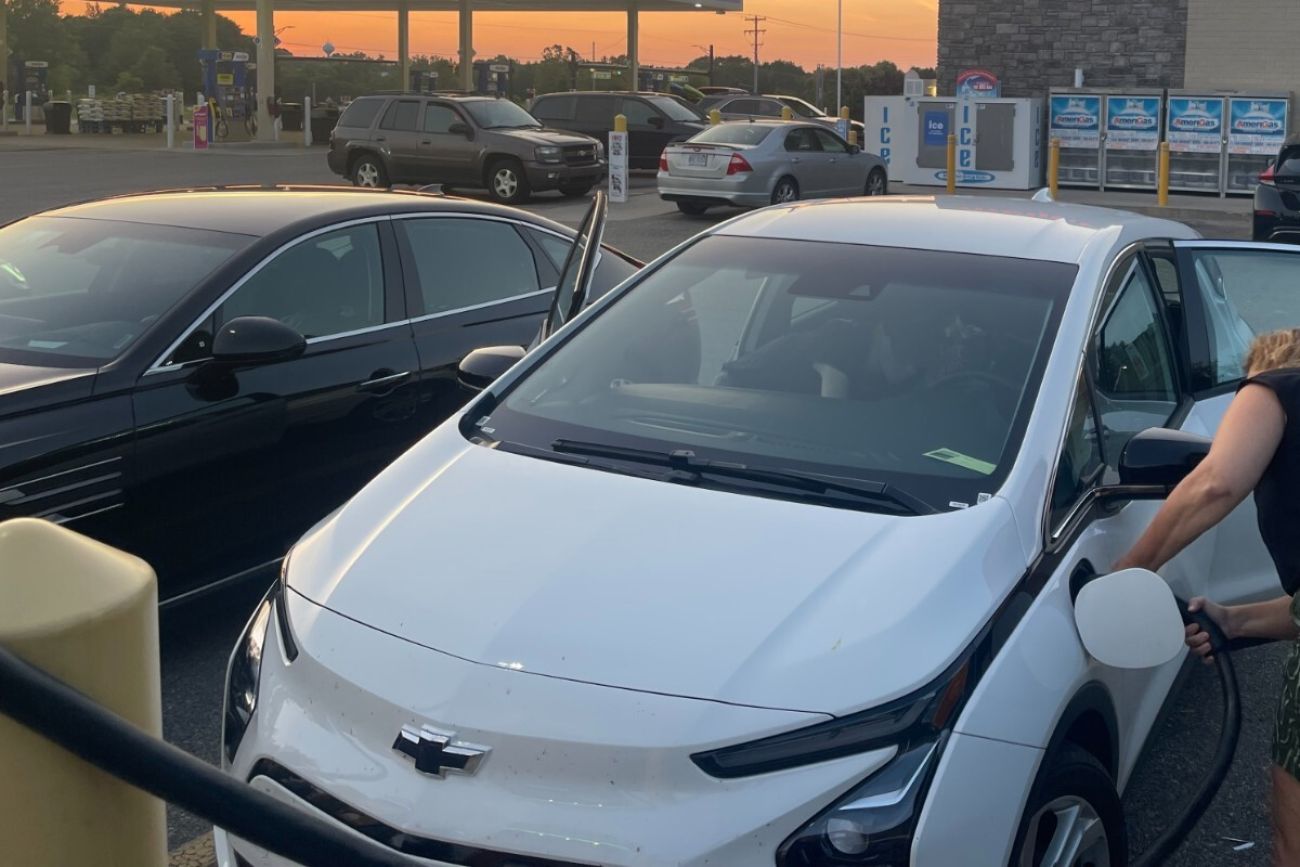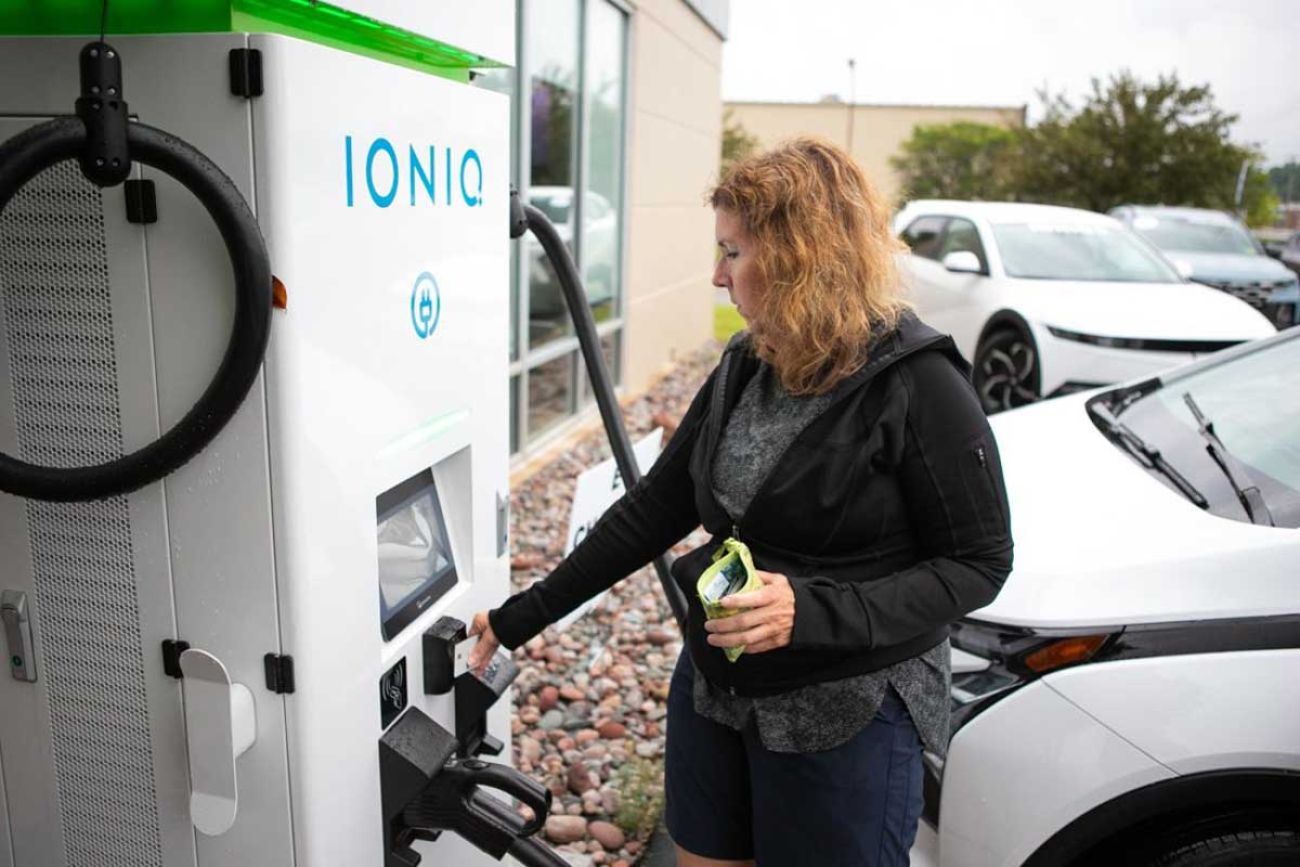EV road trip update: We’re home after more than 1,000 miles

Last updated: Saturday, July 27 at 10:59 a.m. Follow along as Bridge Michigan’s Paula Gardner, Kelly House and Asha Lewis take a 1,000-mile trek around Lake Michigan in a rented EV. Check here throughout the day for their latest adventures.
Why are we doing a road trip? Why did we choose this route around Lake Michigan? Why this car? Read our answers here.
The old motto “home sweet home” fueled our last few hours of the EV road trip.
We took the SS Badger ferry from Manitowoc, Wisconsin, to Ludington, an enjoyable four-hour ride with the Chevy Bolt stowed below deck. (Kelly has a story coming, on the boat, with Asha’s photos and video.)
Our time calculations didn’t account for the waiting to get back into the car, as it was unloaded with dozens of others that included RVs, trucks, one Rivian that we noticed and a few vehicles with dogs sitting in the front seats.
But we’d planned our charging well enough that we had enough battery power to get to a fast charger in Walker. This stop was a Meijer gas station, the first time we used an EV charger at a traditional fueling station.
Notably, we were not alone. Some of the travel destinations around the top of the Michigan mitten had few fellow chargers, but the closer we got to home, the more EV drivers we encountered at charging stations.
By this time, we were used to charging and felt more confident about planning out the number of miles we needed from a charge. Still, our group of three needed about an hour at that point — and, as a famous man once sang, the waiting was the hardest part.
This may have been the moment where we most felt the difference in vehicles: Our instinct after a 13-hour day was to power our way home. Our reality was the hour of waiting — and eventually getting Mexican food from a nearby restaurant.
Ultimately, we made it home, with the last of us walking into her door a bit after 1 a.m.
The grand total of miles traveled: 1,180 — pretty close to Paula’s guess of 1,189 miles.
And the Bolt still had enough charge for about 30 more miles. Paula’s first stop on Saturday morning was to recharge.
(We’re tallying up other metrics for a post after we get a little time to ourselves).
— Paula Gardner
Saturday, July 27
A word about Tesla; power of a robust charging network
We received a lot of questions about the many Tesla mentions in our EV road trip articles, including some requests to more fully cover the electric vehicle company’s founder, Elon Musk.
Across the U.S., Tesla models still top the list of most-sold EVs. This year, its market share is dipping to just over half of the U.S. EV market, with brand sales 6.5 times that of runner-up Ford Motor Co.
In Michigan, home of the auto, Tesla sued the state to allow it to sell vehicles without traditional dealerships. The auto company essentially won in 2020.
Beyond sales, Tesla chargers comprise the world’s largest fast-charging network. Michigan has proportionately fewer than most other states, but the brand still has an outsized presence in the charging network. Tesla branded fast chargers are about 60% of those found in the U.S.
The charger is common enough that it appears to be on the way to becoming the industry’s standard charger. Ford, in fact, has been giving away adapters so Ford buyers can access Tesla chargers.
We learned that fast charging is a game-changer for EV owners seeking to charge on the road. And that the infrastructure dictates so much about EV distance driving. That makes it hard to ignore Tesla in EV travel reporting.
— Paula Gardner
Friday, July 26
Our favorite 5 things to do while charging an EV
GREEN BAY, Wisc. — We’ve made it to the Badger State! We’re at what we expect to be our second-to-last charging stop, about 2.5 miles from the famed Lambeau Field.
What to do? Paula went into Meijer for a few minutes. Asha grabbed a photo of a row of Teslas, We threw away trash.
And then: We worked.
Which raises the question: What ARE the top five things that people could or should do at a charging station, when even a fast charger promises a 40-minute wait?
Here is our list:
- Walk away. Destination options may not be obvious or even fun, but we’ve rarely seen people actually sitting with their car at a charger. This raises questions about whether more chargers could be established next to restaurants, or even tourist destinations.
- Talk to anyone nearby. In our case, it’s usually each other and often about work. But we haven’t been shy about approaching anyone nearby to start a conversation about EVs, the location, and even how to unlock the adapter in a Tesla charging station.
- Check the map. You know you’ll need it, if only to find the next charger. In our case, none of us have followed this route, and it’s been eye-opening to see what’s nearby and what we will miss.
- Feed your travel companions. We saw a couple at a charger unpack the back of a Rivian truck yesterday, only to realize they were digging around for dog bowls and kibble. We’ve gone to the trunk for snacks, and occasionally reach for a treat. Like Skinny Pop.
- Work on your laptop. This is our most-frequent solution. And we’re not just saying that because we’ll be turning this over to an editor. It just feels wrong to not work during a stop, since it’s midday on a Friday and there’s plenty to do.
EV drivers, what did we miss here?
— Paula Gardner
Related:
- Miniature museum in northern Michigan offers wacky take on taxidermy
- EV road trip postcard: Learning the ABCs of charging in Michigan’s UP
- Gretchen Whitmer is all-in on EVs. But state’s fleet is almost all gas powered
- EV road trip postcard: Long-vacant Sleeping Bear Inn reopens after $1.7M rehab
- Up North businesses help fill Michigan’s EV charging station gap
- Up North businesses help fill Michigan’s EV charging station gap
- EV road trip postcard: Cherry Bowl drive-in going strong, despite sale
- EV road trip postcard: A century of history and burgers in Zeeland
- Michigan’s EV evangelists luring 'fence-sitters' away from gas cars
- And they’re off: Bridge begins five-day EV road trip around Lake Michigan

Friday, July 26
What readers really want to know; vanishing doughnuts
MENOMINEE — Our tale of three novices taking an EV trip around Michigan is answering a lot of the questions residents have about electric vehicles.
But not all of them, two readers told us this morning as we did a meetup at Stephenson Bakery on U.S. 41 just a few miles north of the Wisconsin border.
We’ve detailed our experience with charging, range anxiety and discovering the confidence to drive in the Upper Peninsula; now we’re told that people are curious about the EV owning experience.
“What can you expect five years down the road?” Fred Hofer told us that he’s wondering.
Kim Harpt agreed. He told us about his experience as a passenger in a Tesla in California, possibly the smoothest ride of his life, he said.
“If I was buying another vehicle, I would probably go electric,” Harpt said.
That would be possible because of Harpt’s mostly in-town driving. It won’t happen, though, because he’s driving a 2002 GMC Sierra pickup that he’s restored. With 73,000 miles on it. “That’s my last truck,” he said.
People need to know more about real-world expectations as an owner, Hofer said, since they represent a steep investment. The average EV price in June was $56,371, compared to $47,433 for a light vehicle with an internal combustion engine.
Cold, snow, value over time, battery replacement — and costs to repair if a driver hits a deer (pretty common in this area of Michigan) — all would be top of mind beyond our driving experience, we heard.
That’s guidance for us as we plan more EV coverage. We do have some additional reader input from recent emails, including from owners. We’ll post about those soon.
By the way: This bakery is delightful. While we sat at a big round table in the corner, handing out Bridge mugs and stickers, we could see the steady depletion of today’s doughnut supply. And, speaking of readers, we’re told this offers the best kaiser rolls in the state. We’ll have to weigh in after we digest multiple doughnuts.
— Paula Gardner

Friday, July 26
Finding the majesty of Michigan
MANISTIQUE — Our EV Road Trip took a detour on Thursday afternoon to a place where our choice of vehicle mattered not at all.
We stopped to marvel at Kitch-iti-Kipi, Michigan’s Big Spring located in Palms Book State Park.
There, we let some elementary-aged children take charge of the transportation, powering our group across the transparent, 45-feet-deep spring on a wooden raft. We could see sand billowing on the bottom and the biggest trout we’ve come across languidly weave around.
The Upper Peninsula has been our ultimate target since we started charting this trip. We worried, planned, heard warnings and set our expectations to “the best we can do” as we aimed toward the end of the journey.
In the blue-green waters of Kitch-iti-Kipi, we found some of the majesty of the UP. And a reason to pause, breathe deeply and find some peace in the middle of this still-amazing slice of Michigan.
— Paula Gardner
Thursday, July 25
Low battery, high tension; reliving our scariest moment
Our EV adventure has had its share of white-knuckle moments. Let’s just say you don’t know range anxiety until you feel the stress firsthand!
Experience it with us by checking out this Instagram video.
Thursday, July 25
Trying a Tesla Supercharger; a campsite coup
ST. IGNACE — After a stressful Tuesday, we had a much easier time on Wednesday thanks to starting the morning with a full battery.
Free from the burden of recharging throughout the day, we had more time for fun.
That included stopping at a winery and a lavender farm near Petoskey, cruising through the Tunnel of Trees just north of Harbor Springs and having dinner at Legs Inn, a century-old Polish restaurant in Cross Village known for its ornate wood and stonework, lush gardens and stunning view of Lake Michigan. (Thanks for the suggestion, readers!)

Then it was on to Mackinaw City, where we planned ahead to use a Tesla Supercharger before crossing the bridge. Although most Superchargers are available only to Tesla drivers, the company has equipped some with adapters to serve other vehicle types.
(And in what many see as a game-changer that will alleviate “range anxiety” for non-Tesla drivers, many automakers are now selling cars with adapters that allow drivers to use even those Superchargers that aren’t already designed to serve non-Tesla vehicles. It’s a step toward plug point standardization that many say is badly needed).
Figuring out how to use the Superchargers wasn’t intuitive. We got help from Paul, a fellow EV driver who had also stopped to charge.
After downloading the Tesla app (the fourth proprietary charging app we have used on this trip), inputting our payment information and holding a button on the charging station, out popped an adapter that allowed us to plug in.
We paid $7.95 to add 58 miles over 30 minutes. That’s the drawback of fast chargers. They’re more convenient, but also far more expensive than slower Level 2 chargers.
Next, it was back on the road and over the Mackinac Bridge to Straits State Park in St. Ignace, our campsite for the night.
A bit of luck: The rental car agency had provided us with the adapter needed to plug into the electricity pedestal at our campsite — something others had told us not to expect.
We were already 80% full, but the overnight charge pushed us to 100%, leaving us feeling confident as we head off into the charging deserts of the Upper Peninsula.
Time to pack up the tents and head out!
–Kelly House
Wednesday, July 24
Our ‘Speed Racer’ moment in action
We’ve already detailed what it was like to white-knuckle along M-22, wondering if we’d make it to an EV charger before the car’s battery died.
Now you can see us arrive at Mawby Vineyards and Winery, thanks to Glenn Stevens, executive director of MichAuto, the statewide auto advocacy group.
Great to see all of you & your @ChevyElectric Bolt, and glad plugging in relieved the anxiety of rolling in with 13 miles of juice left! Safe travels. pic.twitter.com/DwZAYAYTg6
— Glenn Stevens (@glennrstevens) July 24, 2024
Come meet us!
The Bridge Michigan EV road trip team will have some free time on Friday morning before we head into Wisconsin and across Lake Michigan via the SS Badger ferry.
And we’d love the chance to meet some of our U.P. readers!
We’ll be posted up at Stephenson Bakery, 4000 10th Street in Menominee, from 8-10 a.m. on Friday morning.
Come have a donut and a cup of coffee on us! We’ll also have a limited supply of Bridge Michigan mugs and stickers to give out.
We hope to see you there!
—Kelly House

Wednesday, July 24
Taking time to have some fun
The World’s Largest Cherry Pie Tin — uppercase because it’s an actual name of a roadside attraction near Charlevoix — reminded us that we should be having some fun.
Sure, driving our Chevy Bolt EV, keeping it charged and covering at least 1,000 miles this week is the big goal.
But it’s summer in Michigan, and our mission calls for us to see what’s going on in our beautiful state.
Hence, the pie tin used for a giant cherry pie that let Charlevoix celebrate its cherry dominance. It weighed over 14,000 pounds — or over 17,000 pounds, depending on your source of information.
Until Traverse City stepped in, that is. That’s when the pie record was challenged, with a 28,350-pound pie taking the record 11 years after Charlevoix set it. The record-setting didn’t stop there: Oliver, British Columbia, baked a 39,683 pound cherry pie.
The things you learn when you let yourself stop worrying about EV charging!
We could do this because we started the day with a full charge, giving us 262 glorious miles thanks to an overnight plug-in at Boyne Mountain.
We’re using this freedom to roam around the greater Petoskey area before crossing the Mackinac Bridge later today.
Oh, and here’s more on that cherry pie.
— Paula Gardner

Wednesday, July 24
A full charge at last; heavy rain, flooded streets
BOYNE FALLS — Finally, a full charge.
We’re starting Day 3 with 262 miles of range after plugging into a SWTCH brand charger last night on the grounds of Boyne Mountain lodge.
Getting to Boyne felt like the end of an arduous journey. It wouldn’t be a Michigan road trip if you didn’t get at least one day of torrential rain, and Tuesday was it.
After 80 minutes at Mawby Vineyards and Winery’s Level 2 charger, we had gotten ourselves up to 52 miles of range. Wipers on, we headed toward Traverse City.
The plan was to grab dinner downtown while continuing to fuel up at one of two fast chargers at Clinch Park on the Grand Traverse Bay.
But when we got there, both were out of service. A quick check on PlugShare, an app where EV users rate chargers and report issues, revealed that the next two nearest fast chargers were also offline.
So we wound up in the parking lot of a Hyundai dealership near the airport.
By Up North standards, Traverse City is considered a fast-charging hub with four stations open to our vehicle type (there are others available for Rivian and Tesla owners). Our experience there was a crash course in how the combination of still-sparse fast chargers and a high rate of “downtime” can quickly lead to problems.
After some complications plugging into the dealership’s bulky charger, we got giddy watching the battery range expand on our car’s display screen. We were learning that when road-tripping, fast chargers are king.
It had taken us 30 minutes to add single-digit miles on the wall outlet at Glen Haven. An hour to add about 42 miles at a Level 2 charger in Manistee. Now, we were adding a mile every few seconds.
After 40 minutes, we had gained 125 miles for a total battery range of 159 miles.
It was plenty to get us to our destination, where we had access to Level 2 overnight charging. And enough to get us to the next fast charger if the one at our rental was broken. But still, the day’s experience made us hesitant to unplug.
After some indecision, we pulled the cord and rolled on to Boyne Falls for the night.
We were greeted with flooded streets and parking lots as the rain kept pouring. Luckily, the charging station was on higher ground. When we plugged in around 10 p.m., our vehicle’s display screen indicated we would have a full battery in seven hours.
After our scare yesterday, it feels good to be starting today with a full battery (a first for us). We’ve got some driving ahead, with plans to stop in Petoskey, Carp Lake, and Mackinaw City before camping tonight at Straits State Park. More to come!
— Kelly House
Wednesday, July 24
'Rescued' by a Michigan winery; 13 miles to spare
BOYNE FALLS — The term “range anxiety” doesn’t quite convey how quickly we jumped from attentive driving to extreme stress as we headed up M-22 toward the historic village of Glen Haven.
We’d just charged during a lunch stop in Manistee, which followed quick plug-ins in Pentwater and another Manistee stop, which in turn followed a morning charge that lasted about 90 minutes in Muskegon.
But Kelly announced about 10 miles from Glen Haven that the math was barely in our favor: We had 54 miles of charge to travel 50 miles. And in an EV, we’ve been told, that’s not enough.
We were relieved to be able to use even our slow, Level 1 charger in Glen Haven, where we gave our rented Chevy Bolt a 40-minute boost. The nail-biting experience gave us the sharpest view of what a fast-charging network will mean for the future of EVs: This bare-bones backup gave us three more miles — and promised a full charge by Friday morning.
Yet it was Tuesday afternoon.
Paula took the wheel for the trek to Suttons Bay. That was the plan, and there was no veering off of it, since Mawby Vineyards and Winery’s charger was the closest without risk of rush hour Traverse City traffic.
We got there, thanks to coasting on hills, driving under the speed limit (something we’re sure the drivers behind us didn’t appreciate), turning off the air conditioning and sending every good vibe we had to our EV’s battery. We expanded our margin of error to 13 miles.
Glenn Stevens, executive director of MichAuto, was waiting for us in the parking lot. He runs the statewide automotive advocacy group and is a frequent source on the automotive transition.
Stevens got to witness our relief when we plugged in the car. We asked for his advice.
“You’re novices, and there’s a really big learning curve with EVs,” he said, noting that 80% of charging takes place in a residential garage. “But when you get up to tourist country like this, the infrastructure is just not here.”
Grant money to fund the infrastructure improvements — like $900,000 the state awarded last week to support the Lake Michigan Circuit project — will make the difference, Stevens told us.
“It’s just got to build out,” he said of charging infrastructure.
— Paula Gardner
Tuesday, July 23
Skipping the slots; gambling on battery range
MANISTEE — We had a lot of stops planned on Tuesday, and very quickly realized that we had to cut them short. Sightseeing and charging don’t always mix.
But we did manage a stop at Mears State Park in Pentwater, where the beautiful lakeshore held the first Rivian Level 2 charger spotted on our trip.The charger is the only public charger in Pentwater.
We’d already seen a Rivian truck a day earlier, prompting a short discussion about how the startup EV company caused consternation in Michigan when it moved its headquarters from Plymouth Township to California.
Since then, Rivian has been a bellwether of EV trucks. It awarded a massive $5 billion battery factory to Georgia, expanded its factory in Illinois — a former Mitsubishi plant — then more recently announced it would pause construction of that Georgia factory while EV sales catch up to projections. And so far this year, Rivian sales are up 71%.
We also stopped at Little River Casino Resort, where we ate lunch, wrote stories and charged our Chevy Bolt on the free parking lot chargers.
We bypassed the slot machines and gaming tables.
But there was some gambling going on: the charge during lunch appears to be just enough to get us to our next two appointments: a stop near Sleeping Bear and at a winery. More about those destinations later.
We think we’ll make it. But by late afternoon, we’re starting to speculate about “the dumbest move we made today.”
— Paula Gardner
Tuesday, July 23
Why this car? Why this route? You asked, we answer
Several readers have reached out with questions about the mechanics of our trip, from why we chose our route to how we ended up with a Chevy Bolt. Here’s an attempt to provide some transparency!
- We know this trip won't be a complete picture of what it’s like to own an EV. For drivers who have access to at-home charging, 99 out of 100 days will involve waking up with a fully-charged vehicle, going about your business, and returning home to refill the battery for a fraction of the price of gas. But…
- We are focused on road trips because, quite simply, so are car buyers. Research has shown that fear of “range anxiety” on long trips is perhaps the single biggest deterrent among those considering an EV. We also know that range anxiety is steadily decreasing as battery ranges increase and charging times decline. We wanted to see for ourselves how novice EV drivers would fare on today’s charging network.
- Why Lake Michigan and not other destinations, like the beautiful Pictured Rocks National Lakeshore? Because state officials are focused on this route as they try to build out Michigan’s public charging network. Gov. Gretchen Whitmer has set a goal to make the Lake Michigan shoreline “the best new road trip for electric vehicle owners in America.” We wanted to know how far we have to go.
- We are trying to help readers understand how a newbie will experience an EV, because that’s what the vast majority of Michigan drivers are. Only 0.5% of vehicles registered in Michigan are EVs. That means that, like us, millions of Michiganders will need to overcome a learning curve to make the switch.
- We are learning that the road trip experience can be dramatically different depending what kind of EV you’re driving. We ended up with a Chevy Bolt not by choice, but because it was the only model the rental car agency had in stock. Other EVs may be better-equipped for long road trips because they’re capable of charging faster. But we are finding our groove even with the Bolt’s limitations by timing charging stops around longer stops to eat meals and filing stories from the road.
Do you have questions for us? Let us know! Our emails are khouse@bridgemi.com, pgardner@bridgemi.com, and alewis@bridgemi.com.
– Kelly House and Paula Gardner
Tuesday, July 23
Tips from low-stress Tesla fans
MUSKEGON — After pulling into Muskegon Monday evening with 65 miles left on our charge, we stopped at beautiful Pere Marquette Park to take advantage of free chargers, grab a beer at The Deck, get our first glimpse of Lake Michigan and seek advice from well-traveled EV drivers.
Casey and Cassie Loring are among the group of people we call “EV-angelists,” happy drivers who love to spread the word about electric vehicles. (Read more about them here)
First things first: They warned us that the Chevy Bolt our rental agency provided is about the worst possible EV for a road trip.
The Bolt is a great daily driver, which might explain why it was so popular. But its inability to take full advantage of DC fast chargers makes it a pain on road trips. Unlike its peers that can refill in less than 30 minutes, the Bolt can take well more than an hour.
The Lorings drive Teslas, which means they’re on the opposite end of the “range anxiety” spectrum: Their cars’ long range and ample access to the fast-charging Supercharger network mean they rarely experience it.
The idea of stressing over an empty gas tank “feels like an old-fashioned memory,” Casey said.
Here’s a sampling of the advice Cassie and Casey shared with us about how to manage a five-day trip in a slower-charging car with a more limited range:
- Do your homework: When public chargers aren’t available, you can use a wall outlet or an RV pedestal in a pinch. But you might need an adapter to plug in.
- More homework: Research the apps for charging companies. and install them ahead of time. You don’t want to be standing outside in the rain, waiting for an app to download before you can plug in.
- Still more homework: Always try to find lodging that includes a Level 2 charger, capable of refilling an empty battery overnight. (We already broke this rule. Read below.)
- Fuel up: If you must recharge on the road, time your stops to correspond with meal breaks, sightseeing, or other natural stopping points. Many chargers are intentionally located near restaurants or attractions.
Readers have given us many great tips too. Thank you!
While in Muskegon, we had our first run-in with the mismatch between sparse public chargers and growing EV ownership. There were just two chargers at the beach — not enough to meet demand.
If Casey hadn’t arrived early and saved us a spot, we would’ve been out of luck.
Area EV owners have been lobbying the city to install more public chargers at popular tourism spots like Pere Marquette.
“This was fine in 2016,” when the two chargers were first installed, Loring said. But in 2024, at one of the most popular beaches on Lake Michigan?
“Two at the beach is not enough.”
Before we parted ways, Loring took us for a short ride in his lime green Tesla. “Instant torque,” indeed. It accelerated so fast our backs slammed into the seats.
– Kelly House
Tuesday, July 23
Charging mystery solved
It didn’t take long this morning to solve the mystery of why our car didn’t charge last night: We (or perhaps the previous renters) had unknowingly set the “target charge level” to 130 miles of range.
It’s a feature designed to prevent drivers from waiting around at a charger to eke out a few extra miles, because EVs charge slower the fuller their battery gets.
(Think of filling up a cup of water. You have to slow down as the cup fills to avoid spilling.)
We discovered the issue when Kelly made a trip to the nearest public charger this morning, hoping to get some juice before we hit the road.
Within a few minutes, the ChargePoint app alerted her that the car had stopped charging.
But the car battery was only half full. Googling to investigate the issue, she discovered the “target charge level” feature. A few taps on the EV’s command screen solved the problem.
It’s all part of the learning curve that can make EVs intimidating at first. That’s why experts say education will be key to getting more drivers into EVs.
Purchase price matters. So does charger access. But for many people, the biggest barrier to EV ownership is confidence navigating an unfamiliar technology.
EV owners have told us that within a few days, most drivers get familiar enough with their car to clear the confidence hurdle.
We’re getting there, bit by bit.
— Kelly House
Tuesday, July 23
Charging frustrations mount
As the sun rose over Muskegon, we awoke with a single thought: How did the car do with overnight charging?
Spoiler alert: Not well.
We parked in a residential garage for our first stay, after the short-term rental manager offered the power there for the EV.
All looked good at first. We’d just come from dinner on the lovely and lively Lake Michigan shore, where the 2023 Chevy Bolt was the only EV in the pair of charging docks.
We drove home, dug out the charging apparatus from the crowded back seat and set everything up — then corrected the plug after we got an initial reading of “not connected.” The light was on the charger and it looked like all systems were a go.
Eight hours later, nothing had changed.
Reading online forums over morning coffee is a good way to go crazy. Googling “when a Bolt says it’s full but really at 30%” is not inspiring confidence.
Kelly is heading out to a “real” charger soon. We have our fingers crossed.
— Paula Gardner
Monday, July 22
Learning the ropes
ZEELAND — One early question that environmental reporter Kelly House and I had as we planned this electric vehicle road trip was: What would it be like to drive an EV?
We’d heard various things, including that they’re more fun to drive — kind of like driving a golf cart, one person told me.
Neither of us can say after our first respective shifts on the road that the handling is more fun. In fact, we agree that our rented Chevy Bolt EV feels very much like driving our own cars (Kelly drives a small hybrid and I drive a gasoline-powered SUV).
But there were some differences:
It’s quiet. Very quiet. We knew that from, say, crossing a road near an EV that is moving. But on a highway, where road noise can be nightmarish, the quiet from the EV was a welcome and noticeable difference from so many other vehicles.
The performance metrics are obvious and interesting to watch. There’s a “thermometer” showing how well we meet optimum battery performance. Anything over about 60 mph shot us into the yellow zone (and the car started beeping at 80 mph). Coasting down a hill took us into peak green.
Beyond that, there’s the estimated remaining mileage, which represents the charge. We actually got it to climb while we were east of Grand Rapids. That felt like an accomplishment.
Another gauge shows when regenerative braking kicks in. What an amazing moment when you realize you’re using the brakes to recharge the battery — and watch the gauge climb.
While we’re driving a small car, we also got to test its torque. The instant acceleration was as responsive as any internal-combustion engine (or ICE, as they’re known). We put that to a test while merging onto I-196 to head toward Lake Michigan when another car suddenly appeared from the left just as the lane ended.
Neither digital marketing associate Asha Lewis, Kelly, nor I have been cured of our range anxiety. But, about six hours into this trip, we do recognize how some planning and watching the gauges makes us feel more control over the EV unknowns.
— Paula Gardner
Monday, July 22
Meeting our new ride, first twinge of range anxiety
We're off! But it wasn't exactly smooth.
We confirmed our electric vehicle months ago, but last week's Microsoft software crisis — and subsequent national airline meltdown — created a crush of folks needing rental cars at Detroit Metro Airport on Monday.
Despite some troubles, I, with my colleague Asha Lewis, got a rental car — a 2023 Chevy Bolt — but it was less than half-charged, prompting our first bout of range anxiety. I needed enough juice to drive 109 miles to pick up the third person on our road trip, Bridge environment reporter Kelly House, in Lansing.
So an unplanned pit stop took place this morning before we hit the road. We stopped at an Electrify America charging station I’d written about once, before Congress approved a wave of EV subsidies for manufacturers and buyers.
The good news is, the Bolt is a Michigan-assembled car, with a range of up to 259 miles on a full charge. The bad news is, it’s notoriously slow to charge.
When in production (which ended in December), the Bolt’s $27,495 price tag made it among the most affordable EVs on the market; and, notably, it also qualified for the $7,500 federal tax credit for buyers.
But Bolts charge at a lower wattage than their more expensive counterparts, making them unable to make the best use of public fast-chargers that are designed to get roadtrippers back on the road quickly.
Unlike competitors that charge the battery from 20% to 80% in less than 30 minutes at a fast charger, the Bolt can take well more than an hour. Our charging speed varied from 27 to 38 kilowatts.
After waiting 40 minutes to take the Bolt from 40% to 79% full, we finally set off for Lansing.
— Paula Gardner
Come along for the ride
Bridge Michigan’s EV Road Trip starts Monday and lasts five days. We want readers to come along for the ride.
- Follow along: We’ll document our journey on Bridgemi.com Instagram and Facebook and send daily postcards from the road. To receive them, sign up for our free Environment Watch and Business Watch newsletters.
- Tell us: From Muskegon up to the Mackinac Bridge and along US-2 in the Upper Peninsula, what are your favorite spots? Where should we go?
- Questions: What do you want to know about EVs? What makes you curious about this journey? What would persuade you to make the switch from a gas-powered car?
- Advice: If you’re an EV owner, what advice do you have for us?
- Don’t be shy: Reach out to us at khouse@bridgemi.com, pgardner@bridgemi.comand alewis@bridgemi.com
Michigan Environment Watch
Michigan Environment Watch examines how public policy, industry, and other factors interact with the state’s trove of natural resources.
- See full coverage
- Subscribe
- Share tips and questions with Bridge environment reporter Kelly House
Michigan Environment Watch is made possible by generous financial support from:
Our generous Environment Watch underwriters encourage Bridge Michigan readers to also support civic journalism by becoming Bridge members. Please consider joining today.
See what new members are saying about why they donated to Bridge Michigan:
- “In order for this information to be accurate and unbiased it must be underwritten by its readers, not by special interests.” - Larry S.
- “Not many other media sources report on the topics Bridge does.” - Susan B.
- “Your journalism is outstanding and rare these days.” - Mark S.
If you want to ensure the future of nonpartisan, nonprofit Michigan journalism, please become a member today. You, too, will be asked why you donated and maybe we'll feature your quote next time!






